Causes, Characteristics, Types, Process, Classification, Significance - Plant Succession | 12th Botany : Chapter 7 : Ecosystem
Chapter: 12th Botany : Chapter 7 : Ecosystem
Plant Succession
Plant Succession
We very often see that forests and lands in our areas are
drastically affected by natural calamities (Flood, earthquake) and
anthropogenic activities (Fire, over grazing, cutting of trees). Due to these
reasons all plants of an area are destroyed and the areas become nude. When we
observe this area, over a period of a time we can see that it will be gradually
covered by plant community again and become fertile. Such successive
replacement of one type of plant community by the other of the same area/ place
is known as plant succession. The first invaded plants in a barren area
are called pioneers. On the other hand, a series of transitional
developments of plant communities one after another in a given area are called seral
communities. At the end a final stage and a final plant community gets
established which are called as climax and climax community respectively.
1. Causes of Succession
Ever since the onset of origin of life, organic evolution and
ecological succession are taking place parallelly. Ecological succession is a
complex process. There are three types of causes for any ecological succession.
They are
a. Initiating causes - Activity of abiotic
(light, temperature, water, fire, soil erosion and wind) and biotic factors
(competition among organisms) leads to formation of a barren area or
destruction of the existing community of an area, initiating primary or
secondary succession respectively.
b. Continuing causes - The processes of migration,
aggregation, competition, reaction etc, are the continuing causes which lead to
change the plant communities and nature of the soil in an area.
c.
Stabilizing causes - The stabilization of the plant community in an
area is primarly controlled by climatic factors rather than other factors.
2. Characteristics of ecological succession
·
It is a systematic process which causes changes in specific
structure of plant community.
·
It is resultant of changes of abiotic and biotic factors.
·
It transforms unstable community into a stable community.
·
Gradual progression in species diversity, total biomass, niche
specialisation, and humus content of soil takes place.
·
It progresses from simple food chain to complex food web.
·
It modifies the lower and simple life form to the higher life
forms.
·
It creates inter-dependence of plants and animals.
3. Types of succession
The various types of succession have been classified in different
ways on the basis of different aspects. These are as follows:

1. Primary succession – The development of plant community in a barren
area where no community existed before is called primary succession. The plants
which colonize first in a barren area is called pioneer species or primary
community or primary colonies. Generally, Primary succession
takes a very long time for the occurrence in any region.
Example: Microbes, Lichen, Mosses.
2.Secondary succession - The development of a plant community in
an area where an already developed community has been destroyed by some natural
disturbance (Fire, flood, human activity) is known as secondary succession.
Generally, This succession takes less time than the time taken for primary
succession.
Example: The forest destroyed by fire and excessive lumbering may be
re-occupied by herbs over period of times.
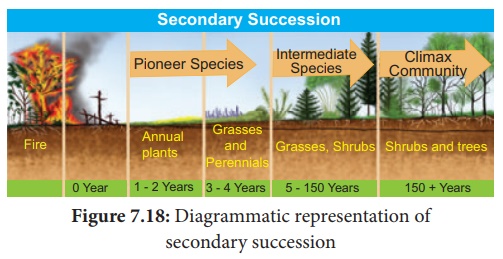
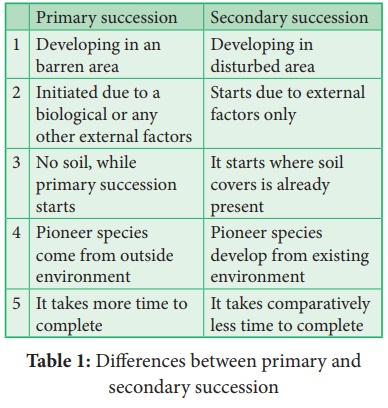
3. Autogenic succession
Autogenic succession occurs as a result of biotic factors.The
vegetation reacts with its environment and modifies its own environment causing
its own replacement by new communities. This is known as
autogenicsuccession.Example: In forest ecosystem, the larger trees produce
broader leaves providing shade to the forest floor area. It affects the shrubs
and herbs which require more light (heliophytes) but supports the shade
tolerant species (sciophytes) to grow well.
4. Allogenic succession
Allogeneic succession occurs as a result of abiotic factors. The
replacement of existing community is caused by other external factors (soil
erosion, leaching, etc.,) and not by existing organisms.Example: In a forest
ecosystem soil erosion and leaching alter the nutrient value of the soil
leading to the change of vegetation in that area.
5. Autotrophic succession
If the autotrophic organisms like green plants are dominant during
the early stages of succession it is called autotrophic succession, this occurs
in the habitat which
is rich in
inorganic substances. Since, green plants dominate in the beginning of
this succession, there is a gradual increase in organic matter and subsequently
the energy flow in the ecosystem
6. Heterotrophic succession
If heterotrophic organisms like bacteria, fungi,actinomycetes, and animals are dominant during the early stages of succession it is called heterotrophic succession. Such a succession takes place in organic habitats. Since heterotrophs dominate in the beginning of such succession, there will be a gradual decrease in the energy content.
4. Process of succession
There are a number of sequential processes in primary autotrophic
succession. They are (1) Nudation, (2) Invasion (migration) (3) Ecesis, (4) Aggregation,
(5) Competition, (6) Reaction (7) Stabilization
(climax).
1. Nudation - This is the development
of a barren area without any form of life. The barren area may be
developed due to topographic (soil erosion, wind action), climatic (hails,
storm, fire), and biotic (human activities, epidemics, etc.,) factors.
2. Invasion - If species invade or
reach a barren area from any other area it is called invasion. When the
seeds, spores or other propagules of plant species reach the barren area, by
air, water and various other agent, it is known as migration.
3. Ecesis(Establishment)-Afterreachinganew area
(invasion), the successful establishment of the species, as a result of
adjustment with the conditions prevailing in the area, is known as ecesis.
If the establishment is complete, the plant will be able to reproduce sexually
in that particular area.
4. Aggregation - The successful
establishment of species, as a result of reproduction and increase in
population of the species than the earlier stage is called aggregation.
5. Competition - It refers to the
aggregation of a particular species in an area which leads to inter
specific and intraspecific competition among the individuals for water,
nutrient, radiant energy, CO2, O2 and space, etc.
6. Reaction - The species occupying a
habitat gradually modify the environmental condition, where the existing
species community is displaced or replaced by another. This is called reaction.
The community which is replaced by another community is called seral
community.
7. Stabilization (Climax stage) - The final establishment
of plant community is called stabilization. This establishment of a plant
community which maintains itself in equilibrium with climax of the area and not
replaced by others is known as climax community and the stage is climax
stage.
5. Classification of plant succession
Detailed study of Hydrosere and Lithosere are discussed below:
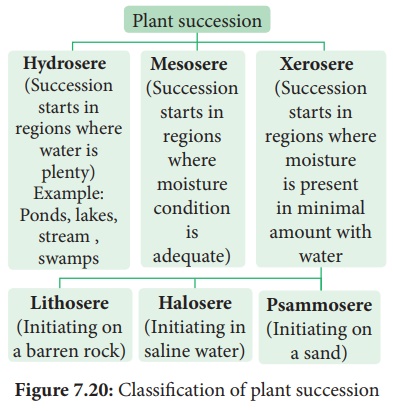
Hydrosere
The succession in a freshwater ecosystem is also referred to as
hydrosere. Succession in a pond, begins with colonization of the pioneers like
phytoplankton and finally ends with the formation of climax community like
forest stage. It includes the following stages Fig 7.21.
1. Phytoplankton stage - It is the first stage of succession
consisting of the pioneer community like blue green algae, green algae,diatoms,
bacteria, etc., The colonization of these organisms enrich the amount of
organic matter and nutrients of pond due to their life activities and death.
This favors the development of the next seral stages.
2. Submerged plant stage - As the result of death and decomposition
of planktons, silt brought from land by rain water, lead to a loose mud
formation at the bottom of the pond.
Hence, the rooted submerged hydrophytes begin to appear on the new
substratum. Example: Chara, Utricularia, Vallisneria and Hydrilla etc.
The death and decay of these plants will build up the substratum of pond
to become shallow. Therefore, this habitat now replaces another group of plants
which are of floating type.
3. Submerged free floating stage - During this
stage, the depth of the pond will become almost 2-5 feet. Hence, the rooted
hydrophytic plants and with floating large leaves start colonising the pond.
Example: Rooted floating plants like Nelumbo, Nymphaea and Trapa.
Some free floating species like Azolla, Lemna, Wolffia and
Pistia are also present in this stage. By death and decomposition of
these plants, further the pond becomes more shallow. Due to this reason,
floating plant species is gradually replaced by another species which makes new
seral stage.
4. Reed-swamp stage - It is also called an amphibious stage.
During this stage, rooted floating plants are replaced by plants which can live
successfully in aquatic as well as aerial environment. Example: Typha,
Phragmites, Sagittaria and Scirpus etc. At the end of this
stage, water level is very much reduced, making it unsuitable for the
continuous growth of amphibious plants.
5. Marsh meadow stage - When the pond becomes swallowed due to
decreasing water level, species of Cyperaceae and Poaceae such as Carex,
Juncus, Cyperus and Eleocharis colonise the area. They form a
mat-like vegetation with the help of their much branched root system. This
leads to an absorption and loss of large quantity of water. At the end of this
stage, the soil becomes dry and the marshy vegetation disappears gradually and
leads to shurb stage.
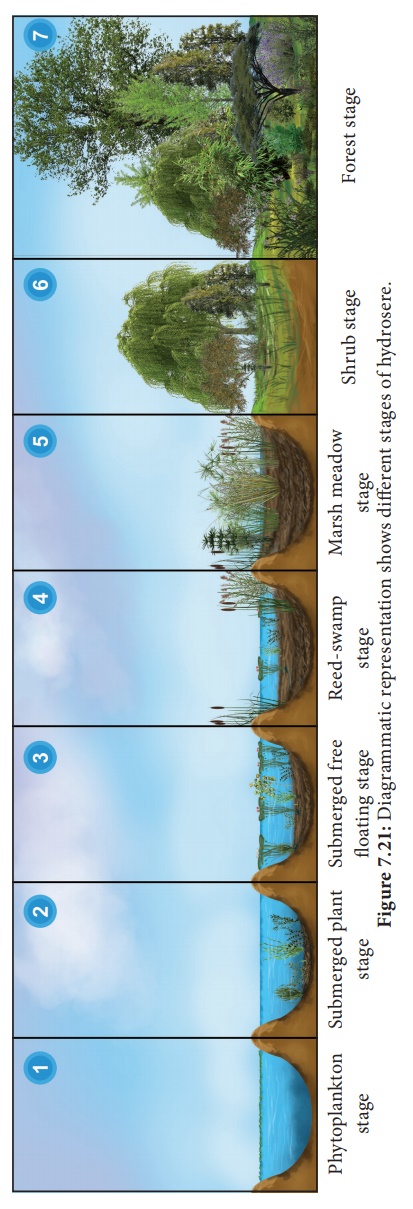
6. Shrub stage - As the disappearance of marshy vegetation continues, soil becomes dry. Hence, these areas are now invaded by terrestrial plants like shrubs (Salix and Cornus) and trees (Populus and Alnus).
These plants absorb large
quantity of water and make the habitat dry. Further, the accumulation of humus
with a rich flora of microorganisms produce minerals in the soil, ultimately
favouring the arrival of new tree species in the area.
7. Forest stage - It is the climax community of hydrosere.
A variety of trees invade the area and develop any one of the diverse type of
vegetation. Example:Temperate mixed forest (Ulmus,Acer and Quercus),
Tropical rain forest (Artocarpus and Cinnamomum ) and Tropical
deciduous forest (Bamboo and Tectona).
In the 7 stages of hydrosere succession, stage1 is occupied by
pioneer community, while the stage 7 is occupied by the climax community. The
stages 2 to 6 are occupied by seral communities.
Lithosere
Lithosere is a type of xerosere initiating on a barren rock
surface. The barren rock is devoid of water and organic matter. A barren rock
surface gets mineral deposits due to weathering. This results in the
colonization of pioneer organisms like crustose lichens. Through a series of
successive seral stages, forest stage (Climax community) is achieved finally.
These series of stages are given below Fig 7.22.
1. Crustose lichen stage - The pioneers like crustose lichens (Rhizocarpon
and Lecanora) secrete some acids which enhance the weathering of rock.
Due to this continuous process, small particles of rocks are formed, which
together with decaying lichen make the first thin layer of soil on rock
surface. However, this process is very slow. At the end, this habitats become
less fit for existing plants and is gradually replaced by another type of
lichens called foliose lichen.
2. Foliose lichen stage - Gradually crustose lichens are replaced
by foliose lichen like Parmelia and Dermatocarpon etc. These
plants have leaf like structures. They also secrete some acids which
further loosen the rocks into small soil particles. This process enhances water
retaining capacity of the habitat and causes further accumulation of soil
particles and humus. Gradual changes make the area less favourable for existing
foliose lichen.
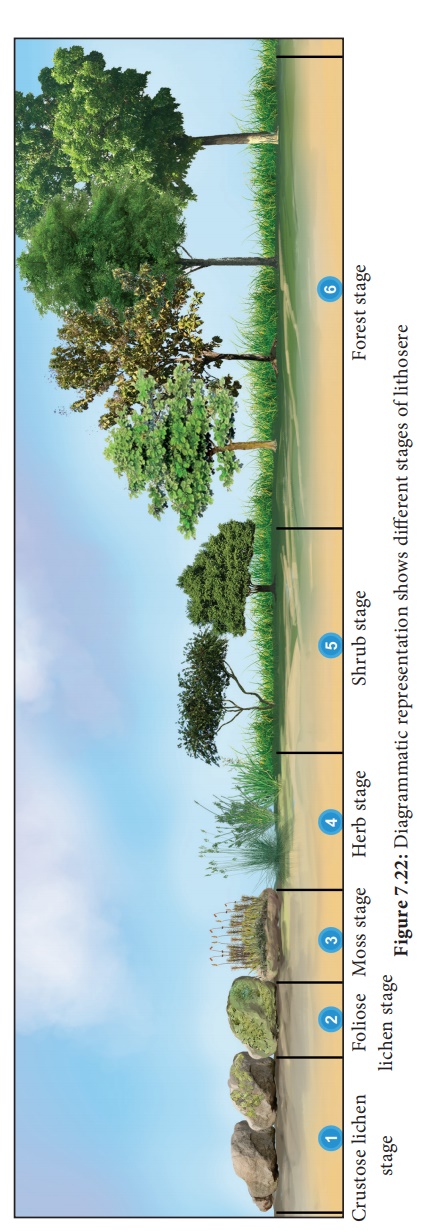
3. Moss stage - When the habitat is
changed, the existing foliose lichen starts disappearing and favours the
growth of some xerophytic moss like Polytrichum, Tortula and Grimmia.
The luxurious growth of moss competes with lichens. Due to the death and decay
of mosses, further addition of humus and moisture to the habitat takes place.
Therefore, the next seral community tries to replace the moss community.
4. Herb stage - With the gradual disappearance of moss
stage, herbaceous plant communities like Aristida, Festuca and Poa,
etc., invade the habitat. The extensive growth of these herbs alter the
habitat. The decaying leaves, stems, root and other parts of these plants get
deposited on the soil surface in the form of humus. It further increases the
water holding capacity of soil. These conditions become more suitable for
shrubs.
5. Shrub stage - The habitat change results in the
invasion of shrubs like Rhus, Zizyphus, Capparis and dominated by
herbaceous plants. The death and decaying of shrubs further enrich the habitat
with soil and humus. Therefore, the shrubs are replaced by trees which
constitute the climax community.
6. Forest stage - The trees capable of growing in
xerophytic condition try to invade the area which was occupied previously by
shrubs. Further increasing the humus content of the soil favours the arrival of
more trees and vegetation finally become mesophytes. As the trees are deeply rooted
and much branched , they absorb more quantity of water and nutrients.
After a long interval, a complete harmony is established among the plant
communities. The climax stage remains unchanged unless some major environmental
changes disturb it
Of the 6 stages of lithosere succession, stage 1 is occupied by
pioneer community and the stage 6 is occupied by climax community. The stages 2
to 5 are occupied by seral communities. Seral stages occurring on the same rock
surfaces.
6. Significance of Plant Succession
·
Succession is a dynamic process. Hence an ecologist can access and
study the seral stages of a plant community found in a particular area.
·
The knowledge of ecological succession helps to understand the
controlled growth of one or more species in a forest.
·
Utilizing the knowledge of succession, even dams can be protected
by preventing siltation.
·
It gives information about the techniques to be used during
reforestation and afforestation.
·
It helps in the maintenance of pastures.
·
Plant succession helps to maintain species diversity in an
ecosystem.
·
Patterns of diversity during succession are influenced by resource
availability and disturbance by various factors.
·
Primary succession involves the colonization of habitat of an area
devoid of life.
·
Secondary succession involves the reestablishment of a plant
community in disturbed area or habitat.
·
Forests and vegetation that we come across all over the world are
the result of plant succession.
Related Topics